Following on from previous articles on the history of calendars and the Metonic cycle, in this article we will be looking at the possible Motonic calendar found at the Hittite Yazilikaya Rock sanctuary in modern day Turkey.
A history of Calendars: Babylon to Greece
A history of Calendars: The Nebra Sky Disk
A history of Calendars: The Ancient World
The Hittite rock sanctuary of Yazilikaya is considered one of the worlds most remarkable archaeological sites. Described as the “Sistine Chapel of Hittite religious art”, along with the capital city of Ḫattuša it one of the most important sources of information we have on the Ancient Hittite religion.

Many text have been found at the ancient city of Ḫattuša relating to solar deities and celestial divination reminiscent of the Babylonian astronomical and astrological practices. One such tablet bears the inscription:
Not again shall I interchange [the festivals] of the spring and of [the autumn] and [the festivals of the spring] I shall perform punctually in the spring, [the festivals of the autumn] I shall perform punctually in the autumn.
The Prayer of Tudḫaliya IV to the Sun Goddess of Arinna
This quote reflect how important the correct timing of religious festivals was to the great king Tydhaliya IV who reigned between 1236-1213 BC, around the same time as the Yazilikaya rock sanctuary was constructed. Although many tablets have been recovered from Ḫattuša, none of them contain a clear reference to the Yazilikaya rock sanctuary, which is within walking distance of the great temple at Ḫattuša being just over 1.6km northeast of the city. Because we have no direct contemporary reference to the site, we do not know it’s original name. The name Yazilikaya means “inscribed rock” in modern Turkish.
The site consists of a number of buildings constructed in three phases surrounding and enclosing the natural rock courtyards where the carved reliefs are that will be discussed in this article (chambers A & B).

Interesting solar alignments have been noted at the site, with the northern wall of building III aligning with the Summer Solstice sunset, and the northwestern wall of building IV aligning with the Winter Solstice sunset. Clearly solar alignment was important at this site, just as it is at many other bronze age sites around the world. Most interesting though for the subject matter of this website, are the carved reliefs in chamber A.
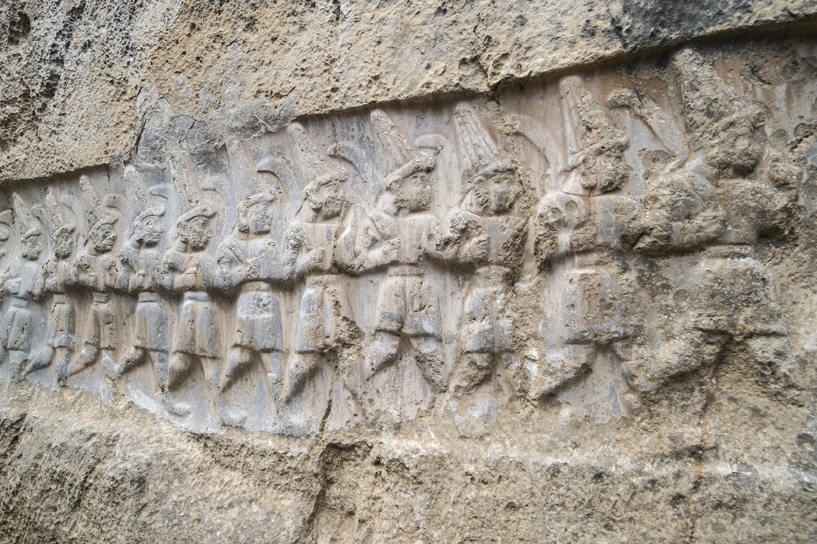
Chamber A is for the most part a natural internal enclosure about 30m long. Along the walls are rock-cut reliefs of 64 deities all facing north. With two exception, all the deities on the left are male, and on the left female, all apparently marching towards an elaborate plateau at the northern end of the chamber where the supreme deities meet. The Hurrian storm god Teššub “the preserver of order in the cosmos”, is pictured on the left standing on the mountain gods Namni and Hazzi, while his wife, the Hurrian goddess Ḫebat, is pictured on the right standing on a leopard. Ḫebat can be equated with the Sun Goddess of Arinna, the chief female deity of the Hittite world. Behind Ḫebat, on her right, are the couple’s son Šarruma and Ḫebat’s daughters Allanzuand Kunzišalli. Most reliefs feature an inscription in Luwian hieroglyphics in front of each figure’s head. A few of these hieroglyphics cannot be read due to weathering of the rock or because the inscriptions have not been deciphered. The figures that do bear an inscription also have Luwian symbol for “deity”, leaving little doubt that these figures represent the Hurrian gods.

Over the years there have been a number of interpretations regarding the function of the site. It has been noted that there is a tantalising parallel between the sequence of gods in Chamber A at Yazılıkaya and the sequence of gods in a ceremony described on the tenth tablet of the so-called itkalzi ritual, found at Ḫattuša. Volkert Haas and Markus Wäfler suggested that Yazılıkaya was the place where the itkalzi ritual was performed. In the course of this ritual, kupti objects were driven into the ground for successive pairs of deities. It is clear from the texts that such rituals were performed outside the town and under the open sky. Yazılıkaya fulfils both of these requirements. Later, Haas added that Chamber A was probably the setting for coronations while Chamber B was a ḫekur, an institution where the ancestors of the royal family were worshipped.
Other authors take Yazılıkaya as the location of the ḫeštā house mentioned in religious texts from Büyükkale, or the mortuary shrine related to the Festival of the Crocus, or as the site where the spirits of the dead kings of Ḫatti dwelt. A few specialists interpret the site as having been the tomb of Tudḫaliya IV. Emilia Masson suggests that once a year, during the winter solstice, a divine assembly took place in Chamber A. It has also recently been suggested that the equinoxes determined the timing of the most important Hittite festivals – AN.TAḪ.ŠUM and nuntarriyashas, in spring and autumn respectively. Jürgen Seeher, head of the excavations in Ḫattuša until 2006, describes Yazılıkaya as the location of the New Year’s feast and the spring feast and also as the home of the weather god. Since the Hittite cultic calendar included up to 165 festivals, many of which were repeated each year, the ability to accurately determine dates and time was naturally of great importance.
Chamber A: a lunisolar calendar?
The deities featured in the reliefs in Chamber A are divided into groups. The first group is of 12 male deities, and there is an identical relief of 12 male deities in chamber B. Both of these could have been used to keep track of the lunar synodic month (the time from one new moon to the next) with a marker moving along the shelf below the relief each month to mark the month. the 12 identical male deities each carry a sickle, which they use to separate the earth from the sky when night falls.
The next group of deities moving around Chamber A from left to right is a group of 30 highly varied “celestial deities”. 30 of course is the maximum number of days in a lunar month, meaning this relief could well have been used to mark the day of the month. References to the sky are abundant too. To the left of this relief are a number of mountain gods, but to the right the figures tend to be bigger and are often winged. Some of the deities found in this relife are Šimegi, the Sun god of heavens, Kušuḫ, the Moon god and Pirinkir, an Ištar-like star, are all identified by their names and prominently participate in this sequence. A connection to celestial bodies is also indicated by the presence of the goddess Šauška (Ištar), who is represented and named both in the male row of gods as the morning star and in the female row on the eastern wall as the evening star and goddess of fertility. It is likely that the ordering of these days actually proceeds from right to left along the relief.
The third group of deities is on the opposite eastern wall, and consists of 19 uniform female deities. Only 17 are visible today, with one completely gone except for it’s inscription, and another was found that matches the others in 1945 in a nearby village. This brings the total number of uniform female deities to 19, which of course is the number of solar years in a Metonic cycle.
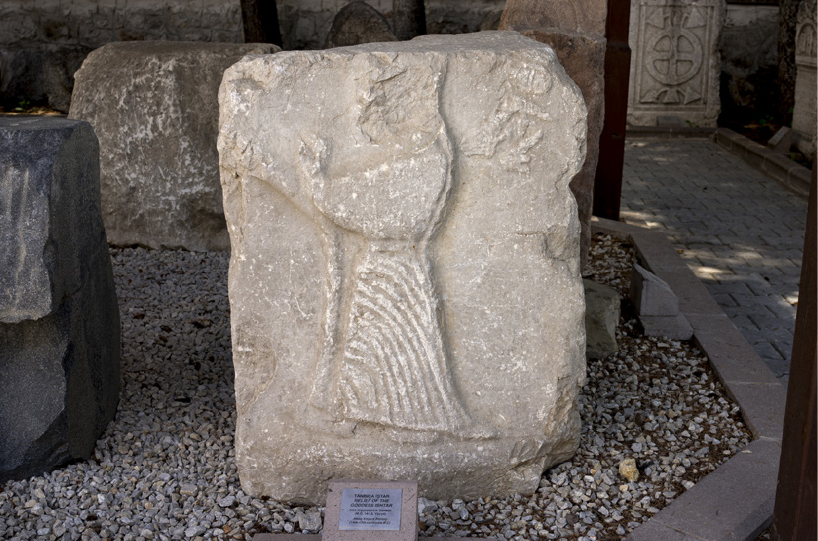
So with groups of 12, 30 and 19 we have everything we need to keep track of the movements of the sun and the moon. the only thing missing is a method of intercalation. I.E. when to insert the additional 7 months required to keep the lunar and solar years in sync.
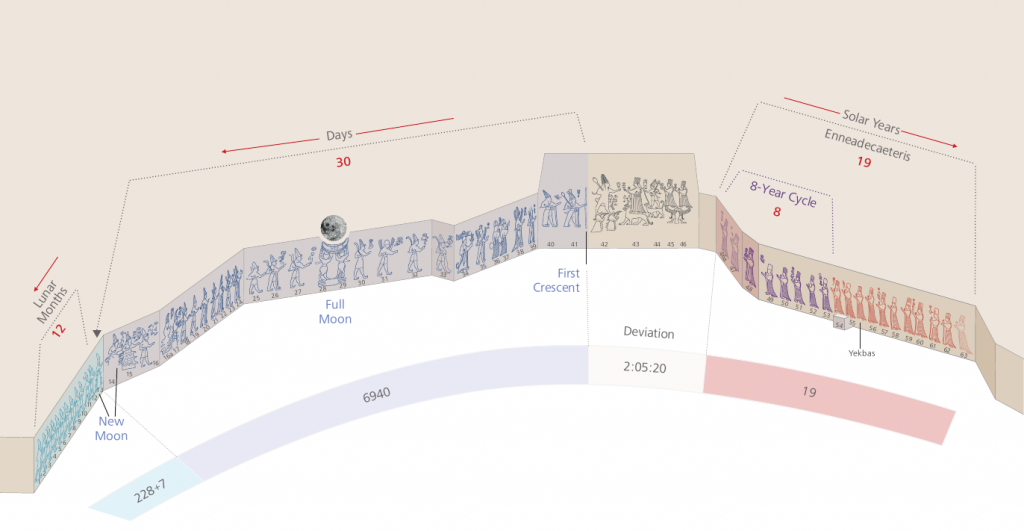
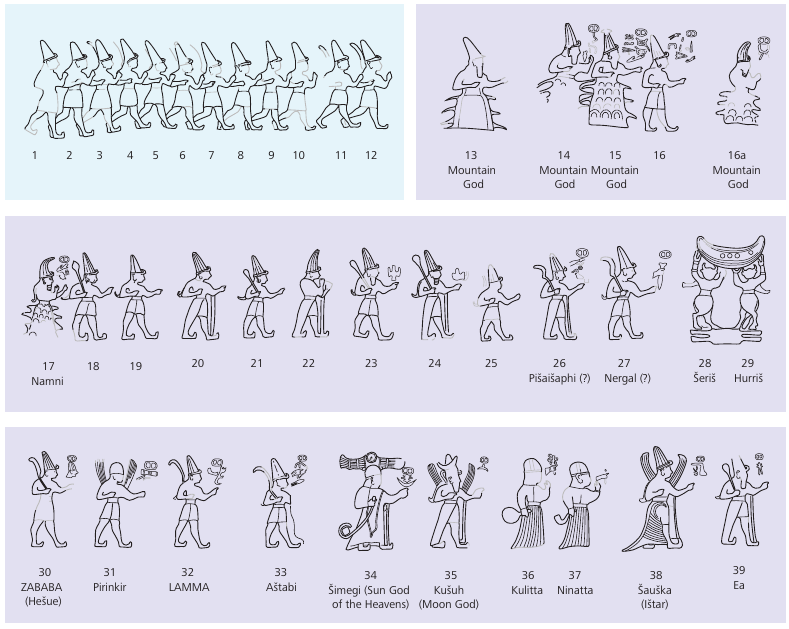
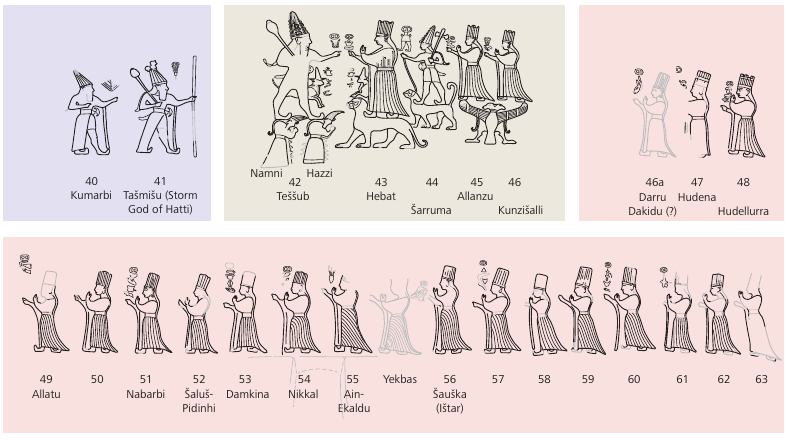
It is believed that the days of the month should be read right to left for a number of reasons. First it is known that the moon held special importance during the Hittite empire. The phase of the Moon played an important role in omen astrology, just as it did in Babylonia. Ancient Near Eastern lore ascribed birth, life, growth and death to the waxing and waning of the Moon, so that the Moon thus occupied a firm place in the household and family cults. On certain occasions, Hittite people baked loaves of bread shaped like the crescent Moon, the Sun or the hieroglyph for “sky”, with stars placed in it, and devoted these to the gods. Second, in the Luwian hieroglyphic script, the direction of reading may change but it always runs counter to the signs with heads and pointing hands. Additionally, in Hittite and Hurrian prayer lists the Moon god Kušuh always precedes the Sun god Šimegi. It is therefore most likely that the deities on the western wall were counted from right to left – just as the Moon travels across the sky.
In ancient Babylonia, the source of much of the specialist knowledge in Anatolian astronomy, the month began with the first appearance of the crescent new Moon. This first day of every month is represented by Tašmišu, the storm god of Ḫatti on the far right of the group marking the days. A long vertical pole carried by this god forms the most conspicuous vertical divider among all the deities, thereby emphasising the beginning of the lunar month. We know that (at least in Egypt) the waxing days before the full Moon had a considerably higher standing than the waning days during the second half of the lunar month. In Yazılıkaya, this ranking becomes obvious, since the echelons within the Hittite pantheon decrease from right to left. The deities for the first half of the month, beginning with
Tašmišu, are much larger and have more individual features in comparison with the later ones. Every single deity before the full Moon bears a name. Still today, the names of some of our weekdays (for instance Sunday and Monday, or Moon-day) are indeed reminiscent of some of these deities. Lesser deities that are smaller in size and less characteristic, and which for the most part do not bear a name, make up the latter half of the month. Each month ended with the new Moon either at Relief 14 or 13, depending on whether the lunar month consisted of 29 or 30 days.
While Tašmišu marks the beginning of the lunar month, the full Moon always coincides with the two bull-men (Reliefs 28–29), located in a conspicuous central place on the panel facing the entrance. Bull-men occur already in Alaca Höyük in an Early Bronze Age context and appear on Syrian seals from the middle of the second millennium BC. The bull-men here may be Hurriš and Šeriš, whose names are indeed Hurrian and stand for “night” and “day” and who in Hurrian cosmogony carry the firmament. Their reliefs are further emphasised here, for they are placed on a podium that corresponds to the Luwian hieroglyphic sign Terra, or “earth”. Jointly, they hold up a large bowl symbolising the Luwian hieroglyphic sign Caelum, or “sky”. This symbol, known in Babylon as elip nūri, has also been interpreted as “the boat”. The Assyriologist Mark E. Cohen mentions a “festival of the boat of light” or “festival of the boat of the Moon” from the Old Babylonian period, which he describes as a sub-festival of the á-ki-ti celebration that was based on the Moon. So, even though the Caelum sign appears as a half Moon, it would represent the full Moon and as such is used to designate the sky as a whole. The full Moon was also, of course, the only night of the month when a lunar eclipse could occur.
Finally the 19 female deities that mark the years are separated by a section of natural rock that divides the group into 8 and 11. It is possible that this 8 year cycle could have been used to track another cycle, such as the 8 year cycle of Venus, or even as another way to reconcile the cycles of the sun and moon. As it turns out, certain Hittite festivals were indeed celebrated once every eight or nine years. So, two different movable markers may have been required. One of these would have travelled along all 19 deities, while the other only passed along the first eight.
While we can’t be certain that the Yazilikaya Rock sanctuary was intended as a Metonic calendar, the evidence for such a use is very strong. There is no indication of how additional months were inserted into the calendar. A written record of a thirteenth-monthly feast for the weather god of Ḫalab (Aleppo) hints at an intercalary month (Haas 2001, 265). In Yazılıkaya, however, different astronomical phenomena could have been used to determine when an intercalary month was necessary. Either the helical rising or helical setting of a bright star such as Sirius, a leap.
However intercalary months were included, this site shows once again that the Metonic sequence was well known throughout the ancient world, and that the Druidcraft calendar of today truly is a reflection of the most ancient calendar system known to humanity.
Leave a Reply
You must be logged in to post a comment.